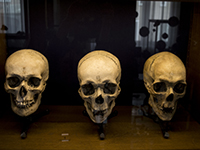Skulls

In 1806 the bodies of three criminals that had received the punishment of being broken on the wheel landed on the disecting table of anatomist Pieter de Riemer. They were members of the infamous gang ‘Zwartjesgoed’ – or ‘Blacks’ - that had left a trail of raids and brutal murders in their wake in the Netherlands. Finally they had been apprehended and sentenced to death.
De Riemer was mainly interested in human skulls from phrenological perspective. Was it possible to read the criminal mindset of these people from the shape of the skull as the founding father of phrenology, the German Franz Joseph Gall believed? To research this, he had collected an extensive amount of skulls of people whom he knew to have been intelligent, criminal or even insane during their lifetime.
In the same year, De Riemer received a visit from Gall himself. He pointed out two skulls to be ‘obvious’ criminals. Too bad for Gall, they turned out to have belonged to two virtuous citizens.
Other skulls in posession of the museum, belong to the collection of Petrus Camper. This famous doctor, anatomist, physiologist and anthropologist collected skulls from all over the world, like the ‘Hottentot’, of the ‘resident of Madagascar’. He measured their exact ‘linea facialis’ or facial angle, to classify different races of humans.
Camper was not judgmental in this endeavour. He was an enlightened scientist with an open mind. He abhorred the idea that one race would be superior to another. He also stated it was impossible to know whether Adam and Eve had been black or white.
| Last modified: | 08 October 2021 3.09 p.m. |

